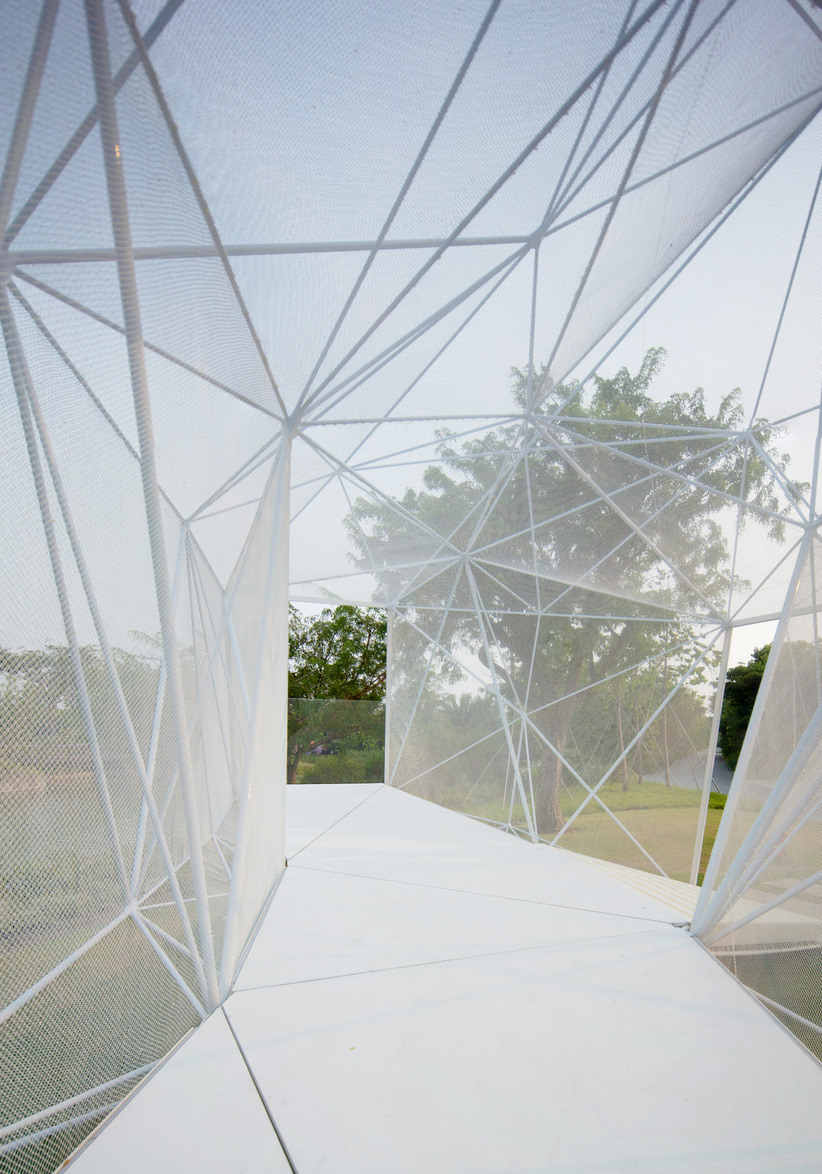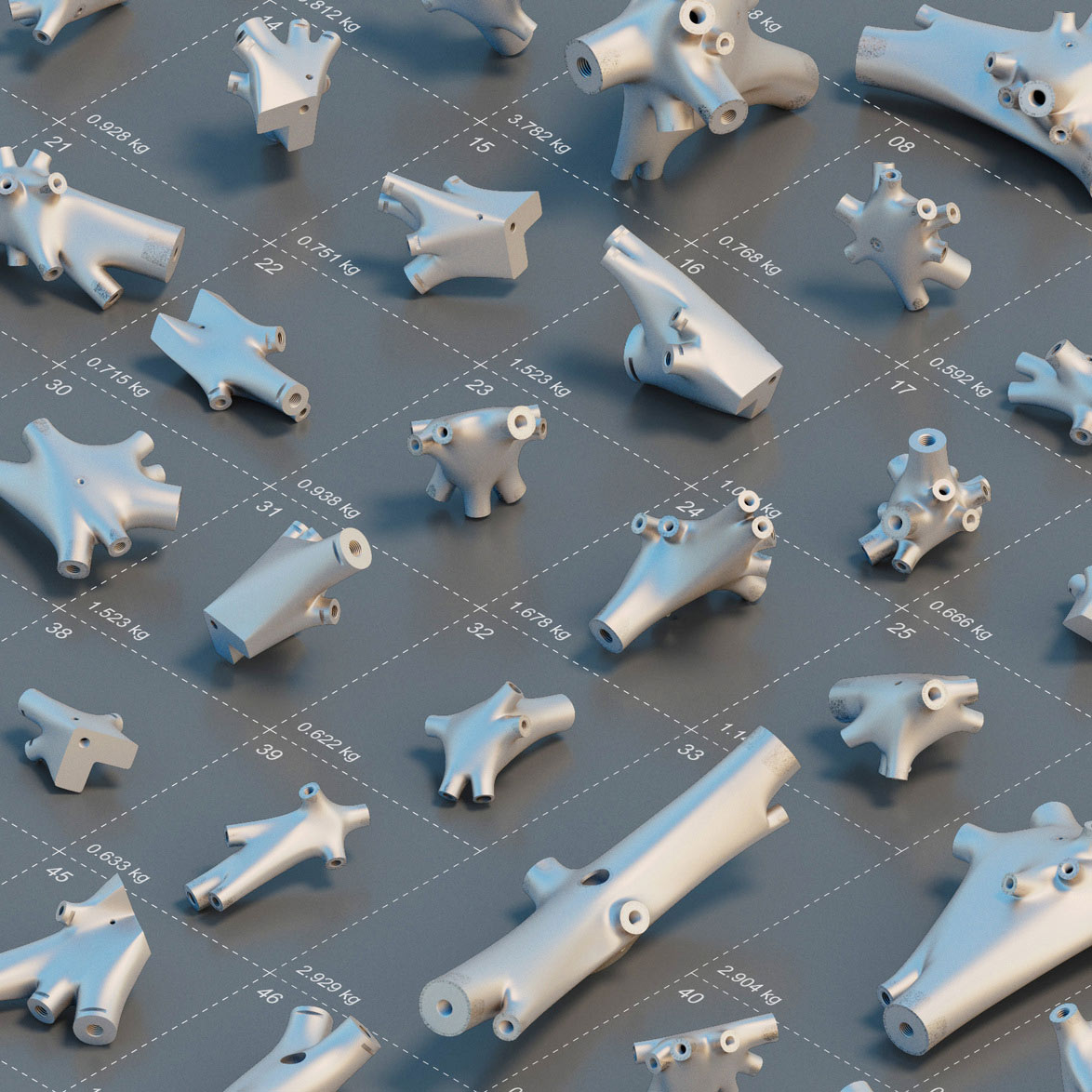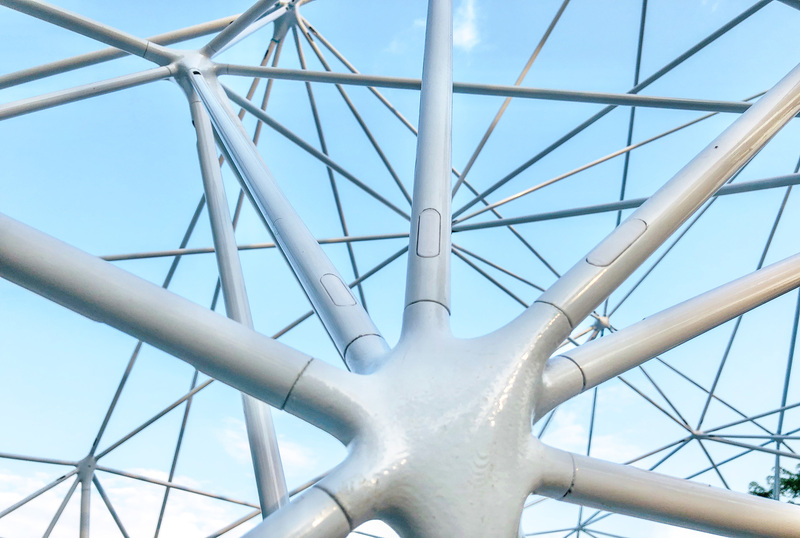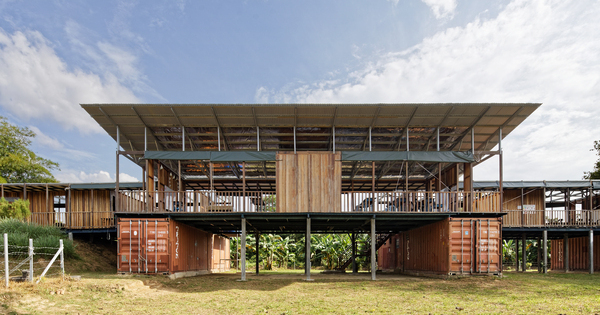DESIGN OF THE YEAR 2020
AirMesh Pavilion
Designer
AirLab @ Singapore University of Technology & Design
Zhejiang University
CONTACT
[email protected]
Sitting atop a grassy knoll at Gardens by the Bay, it lights up in the evenings like a gem. The AirMesh Pavilion is indeed a shining example of what construction in the future could be. It is one of the world’s first fully functional space frame structures made of 3D printed stainless steel components – a resounding proof of concept for a new construction system.
The technology disrupts traditional space frame structures that are limited by standardised nodes and bars. Instead, the pavilion’s complex design is made with 54 bespoke nodes and 216 bars of different lengths and sections to give the most optimal configuration and distribution of material. Such precise customisation was easily achieved with the completely digital workflow, and no materials were wasted as the nodes were manufactured with an additive 3D printing process. The parts were also designed for easy assembly to save construction time and the need for skilled manpower.
Despite such advanced origins, the AirMesh Pavilion’s understated design complements, rather than overpowers, its surrounding natural landscape. It is a model of how design can bring the built and natural environments together for a more sustainable tomorrow.
About the Designer
Founded in 2015 by Carlos Bañón and Felix Raspall, the Architectural Intelligence Research Lab (AirLab) is a multidisciplinary research laboratory focusing on architecture, science, arts, digital design, and manufacturing. It combines new technologies and digital manufacturing to create efficient, light, and versatile products that aim to increase sustainability and reduce wastage in construction.
The laboratory is established at the Singapore University of Technology and Design (SUTD). It is led by Carlos, an architect specialising in Digital Design processes and Advanced Manufacturing methods for the creation of more sustainable spaces and resource efficient products and spaces.
He is also the Co-founder of the award-winning architectural firm Subarquitectura, and an Assistant Professor of Architecture and Sustainable Design at SUTD. Carlos holds a Masters of Architecture from the University of Alicante, Spain. His work has been widely recognised and exhibited globally, such as in the Design Museum of London, and the Venice Biennale of Architecture, as part of the Spanish and Singapore Pavilions.
DESIGNER
AirLab @ Singapore University of Technology & Design
Zhejiang University
CLIENT
Gardens by the Bay
STRUCTURAL CONSULTANT
TCP Consultants Pte Ltd
DESIGNER
AirLab @ Singapore University of Technology & Design
Zhejiang University
CLIENT
Gardens by the Bay
STRUCTURAL CONSULTANT
TCP Consultants Pte Ltd
1A DISAPPEARING ACT
The pavilion is designed to frame three viewpoints around Gardens by the Bay, including its Dragonfly Lake, Marina Bay Sands and the Future of Us Pavilion. It is veiled with a white nylon net in order to recede into the lush, natural landscape.
(Photo by Carlos Bañón)2A DISAPPEARING ACT
The pavilion is designed to frame three viewpoints around Gardens by the Bay, including its Dragonfly Lake, Marina Bay Sands and the Future of Us Pavilion. It is veiled with a white nylon net in order to recede into the lush, natural landscape.
(Photo by Carlos Bañón)3A DIGITAL WORKFLOW
By disrupting traditional design and construction of space frames with a fully digital workflow, the pavilion could easily take on complex forms. A parametric script calculated the angles of the bars and nodes needed to achieve its geometry and generated digital files for 3D printing.
(Photo by Lim Weixiang, Zeitgeist Photos)4A DIGITAL WORKFLOW
By disrupting traditional design and construction of space frames with a fully digital workflow, the pavilion could easily take on complex forms. A parametric script calculated the angles of the bars and nodes needed to achieve its geometry and generated digital files for 3D printing.
(Photo by Carlos Bañón)5EASY TO INSTALL
Each node in the pavilion was printed with rivet threads to allow for quick and simple assembly. It is one example of how the technology can integrate multiple components to enable new and more free-form designs.
(Sketch by Architectural Intelligence Research Lab (AirLab))6TAILORED DESIGN
The pavilion consists of 54 bespoke nodes and 216 bars of different lengths and sections. The customised parts give the design the most optimal configuration and distribution of material.
(Sketch by Architectural Intelligence Research Lab (AirLab))7TAILORED DESIGN
The pavilion consists of 54 bespoke nodes and 216 bars of different lengths and sections. The customised parts give the design the most optimal configuration and distribution of material.
(Photo by Carlos Bañón)8BEACON FOR TOMORROW
By making it easier to construct complex structures with less material wastage, the technology behind the pavilion promises a more sustainable form of construction in the future.
(Photo by Fabian Ong)9Carlos Bañón
(Photo by Ivan Loh, pigscanfly photography)Insights from the Recipient
Carlos Bañón (CB): The pavilion was created for the Gardens by the Bay’s Mid-Autumn Festival 2019. Its faceted form, which reinterprets a traditional Chinese lantern, is based on a technology we have been developing to create lightweight structures. The main difference is the use of 3D printing, which allows for more adaptable and freeform designs. Typically, a space frame is composed with standardised bars and nodes that have a limited number of angles to work with. By using 3D printing, we can design each node as a different geometry to create as complex a structure as needed.
The pavilion was designed in response to the specific site so that it “disappears” into the beautiful landscape. Three viewpoints were chosen — the Dragonfly Lake, the Future of Us Pavilion and the iconic roof of Marina Bay Sands — to generate its shape and openings. We created its stainless steel structure to be as thin and light as possible. The pavilion was then wrapped with a nylon net to create a veil that filters the view and to convey a feeling of lightness.
CB: Typically, one would produce drawings of a structure before sending them to a manufacturer to figure out how to construct it. To design a complex structure such as the AirMesh Pavilion and create it using standard components would have been long-drawn and challenging. Any minor deviations would have compromised the accuracy of the final structure. Our technology automates the design process. Based on the specified geometry, our parametric script calculates the angles of the bars and nodes and generates the different designs as digital files. These are then sent directly to the printer. There are no errors because you can digitally review all the documentation and the 3D model.
We also simplified the construction sequence by integrating as many components as possible into the nodes and bars. They come printed with rivet threads so connecting a node and bar is akin to assembling one big piece of IKEA furniture. The pavilion was assembled by six graduate students working in teams of three. You don’t need very skilled human resources. In a sense, we have made an ultra-high-performance structure accessible to more people.
CB: Our goal was to create as light a pavilion as possible, while still maximising its performance. The new workflow removed a lot of unnecessary construction as we could control every single inch of material placed in the pavilion. As opposed to standard components that needed to be modified and adapted to fit the design, our algorithm allowed us to determine the performance required and even the detailing of the parts. The pavilion was printed in stainless steel, whose mechanical properties are as good as what is used in construction today.
There was also no material wastage during fabrication because 3D printing is an additive process. The environmental impact of manufacturing processes, such as their contribution to global warming, is also commonly underestimated in the construction sector. The use of 3D printing with data-driven digital models helps us more accurately measure and reduce material consumption, wastage, water usage and emissions.
CB: Architecture is moving very, very quickly into digital design. Many decisions that were previously based on intuition can now be informed using algorithms. Architects need to be trained to adapt to this new way of thinking, integrating coding in the learning sequence. It is not just about how to use the tools but how to think with them. We are moving towards more data-driven designs, integrating data points from the environment, structural performance and even budget constraints. The problem with some digital strategies is that they rely solely on specific software tools to validate decisions, even though the premises might be wrong. As architects, we still need to make informed decisions based on selected layers of complexities, and to have the ability to articulate them in a relevant and meaningful way.
I’m very proud that it is not apparent to people that AirMesh Pavilion was digitally designed or even 3D printed. I wanted to create an experience and atmosphere that people would feel right in, without shouting in their face that it was digitally designed.
CB: The system is scalable, and we could print larger structures like a bus stop or a canopy of a sports hub. You can design different forms based on the context instead of being constrained by standard components which give limited shapes. Everything can be more adaptive, and the door to architectural freedom is unlocked. And it is not costlier to have variations as long as the amount of material used is similar.
With 3D printing, you can also integrate the many separate building components into a single piece. A node could be hollowed for running services or electronics inside. This reduces the number of layers a building needs as well as the time needed to construct it. As the connections become seamless, it brings a radically new kind of aesthetic to architecture.
The next step for us is to use the system to make a permanent structure. This small pavilion has already gotten the world’s attention. It would be great to see Singapore print something of a larger scale, perhaps bridges, long-span shelters, or multi-storey spaces to demonstrate our confidence in this technology and blaze a path for the future.
Citation
Jury Citation
Nominator Citation
Dr Toni Kotnik
Professor of Design of Structures
Aalto University, Helsinki
AirMesh Pavilion and the technology behind it put Singapore firmly at the forefront of global additive manufacturing of complex structures. The pavilion is an emphatic proof of concept and the first in the world to be made out of 3D printed stainless steel components.
Each of its bespoke joints was designed to receive as many as 25 individual elements in pure axial force. Its organic shape resembles the human heart in an eye-opening coincidence, pointing to the hypothesis that nature creates the most appropriate, efficient and desirable forms and shapes. As these joints are printed, it drastically reduces the use of materials and the entire structure’s embodied carbon footprint. It also allows for rapid deployment, such as the construction of dignified shelters for disaster relief.
The design’s overall congruence with nature helps to integrate the built and natural environments. It is an ambition that ought to be that of all designers. The Jury feels strongly that design innovations of this kind – with a strong ethos, sophisticated process, leading to an environmentally congruent product with significant impact –are deserving of recognition and a P*DA.
AirMesh Pavilion is a technological achievement that opens up new possibilities in architectural practice. Its creators were able to create a seamless and highly functional digital chain from design to fabrication by connecting and coordinating a set of software as well as 3D steel printing technologies. The interdisciplinary exchange of expertise has produced a new design tool for architecture.
It allows for the precise control of the flow of forces and allocation of material, resulting in a highly resource efficient structure of unprecedented lightness. The coherent workflow is robust and independent of scale, which makes the research applicable to a much larger building scale.
Besides a technologically advanced digital workflow and an efficient use of material, AirMesh Pavilion also demonstrates a new aesthetic of ephemeral construction. The radical aesthetic of nothingness may be seen as the future of sustainable design. It is a successful merger of design and technology, and has relevance far beyond Singapore.













